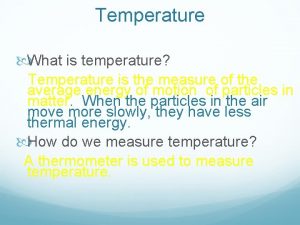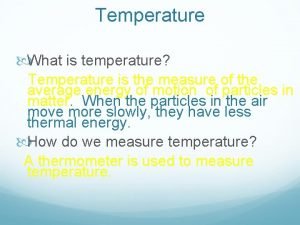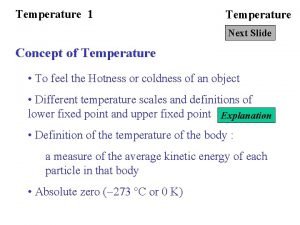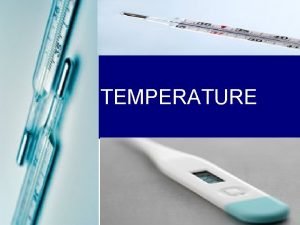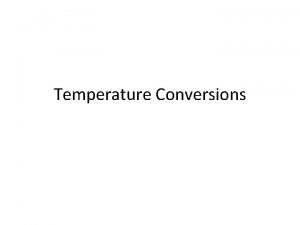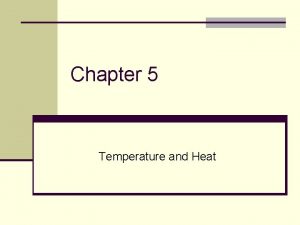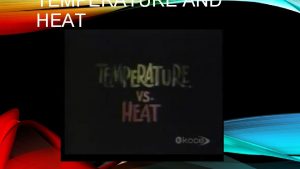High Performance High Temperature Materials for High Efficiency









- Slides: 9

High Performance, High Temperature Materials for High Efficiency Power CPS # 34924 Oak Ridge National Laboratory/Argonne National Laboratory/Siemens Corp. July 1, 2019–June 30, 2022 B. Pint, Oak Ridge National Laboratory U. S. DOE Advanced Manufacturing Office Virtual Program Review June 2 -3, 2020 This presentation does not contain any proprietary, confidential, or otherwise restricted information.

Overview Project Title: High Performance, High Temperature Materials for High Efficiency Power Project Budget and Costs: Budget $2, 060, 00 0 Approved Budget (BP- $2, 060, 00 1&2) 0 Costs as of 3/31/19 $555, 356 Overall Budget Timeline: Project Start Date: 07/01/2019 Budget Period End Date: 03/31/2020 Project End Date: 06/30/2022 DOE Share Cost Share Total Cost Share % $0 $2. 060. 000 0% $0 $2, 060, 000 0% $1, 200 $556, 556 0. 2% Barriers and Challenges: Project Team and Roles: • • ORNL: Technical lead on 3 tasks • ANL: advanced characterization • Capstone Turbine Corp: 65 k. W turbine operation and durability testing • Solar Turbines: field-exposed specimens • Siemens Corp: provide coatings for testing; feedback on test conditions and modeling • Tennessee Technological University: fabricate coatings for hot corrosion testing • • Developing materials for ≥ 100°C increased temperature operation Validating a component lifetime model using field exposed specimens Identifying hot corrosion coating solutions with good mechanical properties for better fuel flexibility AMO MYPP Connection: • CHP Materials challenges: lack of economical materials that can operate at higher temperatures and resist corrosion • Cost and complexity of installation and operation. • Reliability, availability, maintainability, and durability • Scalability: higher-efficiency 1 -5 MW systems • Fuel flexibility: including renewable fuels

Project Objective(s) Develop higher performance and lower-cost materials to increase combined heat & power (CHP) system efficiency Higher temperatures are needed to improve system efficiency Innovative, high-temperature materials often are significantly more expensive or less reliable than current materials for 25 -40 kh lifetimes Objective: Develop materials solutions for ≥ 100°C using lifetime modeling validated by laboratory experiments and field exposures in conjunction with industry partners Approach: Identify materials solutions using laboratory experiments, field exposures, advanced characterization and validated lifetime models Industrial partners provided feedback and field exposed components Target: ≥ 100°C temperature increase Evaluating alumina-forming austenitic steels and hot c 0 rrosion coatings with appropriate fatigue resistance (High Performance, High Temperature Materials for High Efficiency Power)

Technical Innovation Identifying high performance materials with reasonable cost to enable higher efficiency CHP systems Alumina-forming austenitic steels can achieve strength and oxidation resistance comparable to Higher temperatures are needed to improve system efficiency Innovative, high-temperature materials often are significantly more expensive or less reliable than current materials for 25 -40 kh lifetimes Objective: Develop materials solutions for ≥ 100°C using lifetime modeling validated by laboratory experiments and field exposures in conjunction with industry partners Approach: Identify materials solutions using laboratory experiments, field exposures, advanced characterization and validated lifetime models Industrial partners provided feedback and field exposed components Target: ≥ 100°C temperature increase Evaluating alumina-forming austenitic steels and hot c 0 rrosion coatings with appropriate fatigue resistance (High Performance, High Temperature Materials for High Efficiency Power)

Technical Approach Excellent industry team feedback on experiment parameters and critical materials issues Evaluating new materials in laboratory testing ORNL Alumina-forming austenitic steel (Fe-base) 850°C maximum temperature (Task 1) Newly patented Ni-base alumina-forming alloy 1150°C maximum temperature (Task 2) Candidates coatings from industry 700°C hot corrosion and fatigue testing (Task 3) Modeling (Tasks 1 and 2) Challenges Material available from industry partners or made at ORNL Choosing correct experiment parameters: industry feedback SO 2 requires additional safety reviews (High Performance, High Temperature Materials for High Efficiency Power)

Technical Approach Modeling approach: Predict oxidation kinetics Predict compositional changes (Cr-depletion) Oxidation lifetime diagram 800°C, 0. 1 mm foil Dry air 800°C, 10, 000 h, 0. 1 mm foil Air + 10 % H 2 O Measured Calculated Parameters: %H 2 O, gas velocity, duty cycle, wall thickness… Failure criteria: Using drop to 10%Cr at surface for initial predictions Observations from field exposed material may alter that metric (High Performance, High Temperature Materials for High Efficiency Power)

Results and Accomplishments (1 slide max) Milestone/Tasks Status Milestone 1. 1 (Y 1/Q 1, FY 19/Q 4): Begin testing of new model alloys with different Mn levels Achieved Milestone 1. 2 (Y 1/Q 2): Quantify alloy foil reaction rates after 1, 000 h at 850°C Achieved Milestone 1. 3 (Y 1/Q 3): Identify 2 corrosion coatings for fatigue testing In Progress Smart Milestone 1. 4 (Y 2/Q 4, FY 20/Q 3): Evaluate 3 candidates based on 5, 000 h 850°C exposures In Progress Milestone 2. 1 (Y 2/Q 1): Initiate creep testing on new foil alloys Achieved Milestone 2. 2 (Y 2/Q 2): Complete at least 3 fatigue experiments in SO 2 In Progress Milestone 2. 3 (Y 2/Q 3): Submit journal paper on lifetime modeling In Progress Smart Milestone 2. 4 (Y 2/Q 4): Evaluate ≥ 2 coatings in corrosion and fatigue In Progress Go-No Go Decision (Y 2/Q 4): Identify 1 coating with adequate corrosion & fatigue In Progress Milestone 3. 1 (Y 3/Q 1): Quantify precipitates in new alloy at ANL In Progress Milestone 3. 2 (Y 3/Q 2): Submit journal paper on coating fatigue behavior In Progress Milestone 3. 3 (Y 3/Q 3): Validate lifetime model In Progress Smart Milestone 3. 4 (Y 3/Q 4): Using model, predict behavior within ± 1 s of experiments In Progress AFA steel has performed well after >2, 000 hr at 850°C in laboratory testing in simulated exhaust gas (air + 10%H 2 O) New equipment under construction for conducting fatigue testing under hot corrosion conditions (SO 2 containing gas) (High Performance, High Temperature Materials for High Efficiency Power)

Results and Accomplishments (1 slide max) Material received from industrial partners: Solar Turbines: provided foils exposed 106, 000 hr in Mercury 50 duct Capstone: removed rainbow recuperator after 15, 000 hr operation Siemens: coatings for hot corrosion testing AFA steel has performed well after >2, 000 hr at 850°C in laboratory testing in simulated exhaust gas (air + 10%H 2 O) Initial results show promising results for two hot corrosion-resistant coatings New equipment under construction for conducting fatigue testing under hot corrosion conditions (SO 2 containing gas) Modeling simulations initiated using advanced physics-based models and High-Performance Computing infrastructure (> 200 computational cores) to allow rapid predictions of material behavior during exposures in air + 10%H 2 O for up to 100 kh as a function of time, temperature, alloy composition and gas flow rate. (High Performance, High Temperature Materials for High Efficiency Power)

Transition First patent awarded for Ni-based alumina-forming alloy for 1150°C application in January 2019 Office actions are being pursued for a second patent on this class of alloys Engaging with industry to increase TRL level to 4 -5 for new Ni-based alloys and Fe-based AFA alloys Discussions with alloy manufacturers and end users Fabricating larger heats of new alloys (High Performance, High Temperature Materials for High Efficiency Power)
 Productive inefficiency and allocative inefficiency
Productive inefficiency and allocative inefficiency Allocative efficiency vs productive efficiency
Allocative efficiency vs productive efficiency Allocative efficiency vs productive efficiency
Allocative efficiency vs productive efficiency Difference between curie temperature and neel temperature
Difference between curie temperature and neel temperature Difference between curie temperature and neel temperature
Difference between curie temperature and neel temperature Difference between curie temperature and neel temperature
Difference between curie temperature and neel temperature Natural materials and man made materials
Natural materials and man made materials Useful or harmful
Useful or harmful Man made map
Man made map Adapting and adopting materials
Adapting and adopting materials










